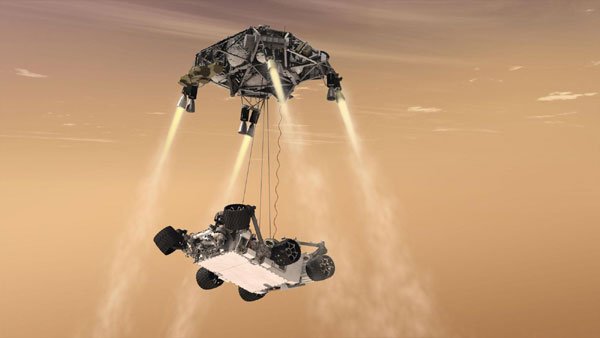Mars rover nears make-or-break landing attempt
Updated: 2012-08-05 18:45
(Agencies)
|
|||||||||||
 |
|
This artist's concept shows the sky crane maneuver during the descent of NASA's Curiosity rover to the Martian surface. By the time the robotic Mars laboratory dubbed Curiosity streaks into the thin Martian atmosphere at hypersonic speed on Sunday night, the spacecraft will be in charge of its own seven-minute final approach to the surface of the Red Planet. [Photo/Agencies] |
PASADENA, Calif - The Mars rover Curiosity, on a quest for signs the Red Planet once hosted the building blocks of life, streaked into the home stretch of its eight-month voyage on Sunday nearing a make-or-break landing attempt NASA calls its most challenging ever.
Curiosity, the first full-fledged mobile science laboratory ever sent to a distant world, was scheduled to touch down inside a vast, ancient impact crater on Sunday at 10:31 pm Pacific time (1:31 am EDT on Monday/0531 GMT on Monday).
Mission control engineers at the Jet Propulsion Laboratory near Los Angeles acknowledge that delivering the one-ton, six-wheeled, nuclear-powered vehicle in one piece is a highly risky proposition, with zero margin for error.
But on the eve of Curiosity's rendezvous with Mars, JPL's team said the spacecraft and its systems were functioning flawlessly, and forecasts called for favorable Martian weather over the landing zone.
After a journey from Earth of more than 350 million miles (567 million km), engineers said they were hopeful the rover, the size of a small sports car, will land precisely as planned near the foot of a tall mountain rising from the floor of Gale Crater in Mars' southern hemisphere.
Flight controllers anticipate clear and calm conditions for touchdown, slated to occur in the Martian late afternoon. There may be some haze in the planet's pink skies from ice clouds, typical for this time of year, with temperatures at about 10 degrees Fahrenheit.
"We're on target to fly through the eye of the needle," Arthur Amador, the Mars Science Laboratory mission manager, told reporters at a briefing on Saturday, as Curiosity hurtled to within 2.8 million miles (4.5 million km) of its destination.
Facing deep cuts in its science budget and struggling to regain its footing after cancellation of the space shuttle program - NASA's centerpiece for 30 years - the agency has much at stake in the outcome of the $2.5 billion mission.
Mars is the chief component of NASA's long-term deep space exploration plans. Curiosity, the space agency's first astrobiology mission since the 1970s-era Viking probes, is designed primarily to search for evidence that the planet most similar to Earth may have once have harbored ingredients necessary for microbial life to evolve.
PACKED WITH GADGETS
The rover, formally called the Mars Science Lab, is equipped with an array of sophisticated chemistry and geology instruments capable of analyzing samples of soil, rocks and atmosphere on the spot and beaming results back to scientists on Earth.
Nearing the end of its journey encased in a capsule-like shell, Curiosity was essentially flying on automatic pilot, guided by a computer packed with pre-programmed instructions.
Mission control was due to activate the craft's backup computer on Sunday, ensuring that it will assume onboard command of the vessel should the primary computer fail during entry into the Martian atmosphere and its tricky descent to the surface.
Two hours before atmospheric entry, mission control will send its very last transmission to Curiosity, a "parameter update" giving the craft its exact position in space.
After that, controllers will have little to do but anxiously track Curiosity's progress as it flies into Mars' upper atmosphere at 13,000 miles (20,921 km) per hour, 17 times the speed of sound, and begins a descent and landing sequence NASA refers to as "the seven minutes of terror."
Curiosity's fate will then hinge on a complex series of maneuvers that include a giant parachute deployment and a never-before-used jet-powered "sky crane" that must descend to the right spot over the planet, lower the rover to the ground on nylon tethers, cut the cords and fly away.
"This is the most challenging landing we've ever attempted," said Doug McCuistion, NASA's Mars Exploration Program director.
If everything works according to plan, controllers at JPL will know within a minute or two that the Curiosity is safely on the ground, alerted by a terse radio transmission relayed to Earth from the Mars orbiter Odyssey flying overhead.
If no landing signal comes, it could take hours or days for scientists to learn if radio communications with the rover were merely disrupted or that it crashed or burned up during descent.
From 154 million miles (248 million kilometers) away, 1,400 scientists, engineers and guests are expected to tensely wait at JPL to learn Curiosity's fate. Another 5,000 people will be watching from the nearby California Institute of Technology, the academic home of JPL.
A NASA Television broadcast from mission control will take over the giant Toshiba screens in Times Square in New York City.
In a good-luck tradition dating back to the 1970s, engineers in the control room at JPL plan to break out cans of roasted peanuts about an hour before landing.
Related Stories
NASA creates menu for Mars mission in 2030s 2012-07-18 08:06
NASA rover closing in on Mars to hunt for life clues 2012-07-30 11:07
NASA rover on Mars sends panorama image 2012-07-10 14:00
Today's Top News
President Xi confident in recovery from quake
H7N9 update: 104 cases, 21 deaths
Telecom workers restore links
Coal mine blast kills 18 in Jilin
Intl scholarship puts China on the map
More bird flu patients discharged
Gold loses sheen, but still a safe bet
US 'turns blind eye to human rights'
Hot Topics
Lunar probe , China growth forecasts, Emission rules get tougher, China seen through 'colored lens', International board,
Editor's Picks

|

|

|

|

|

|





